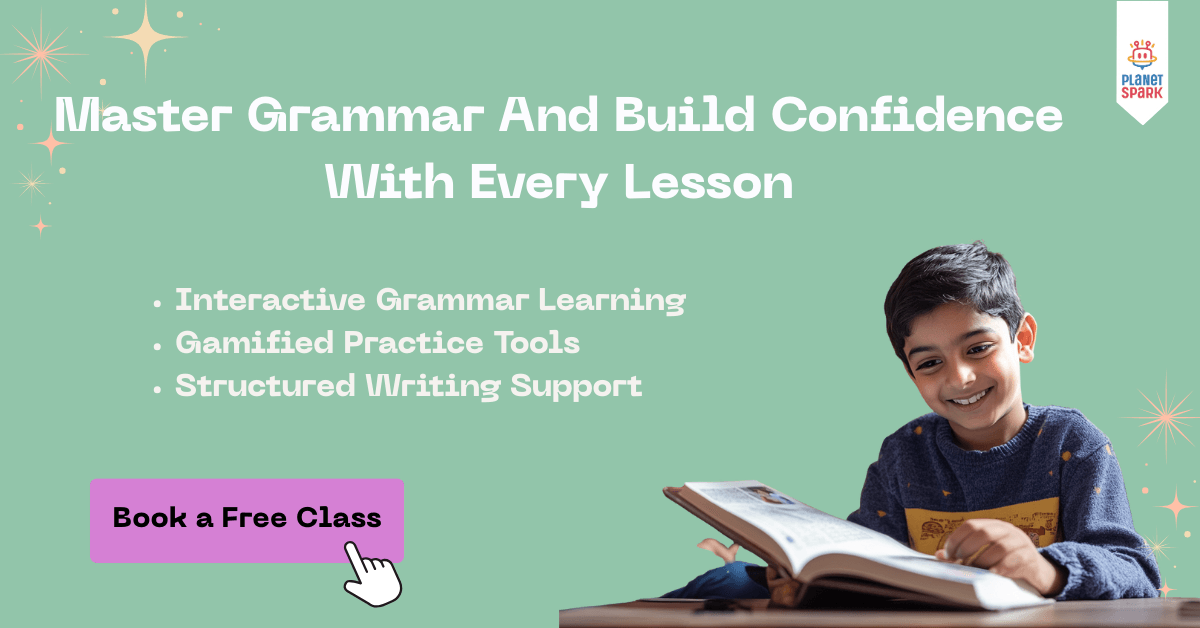Punctuation for Class 1: Easy Rules, Examples & Worksheets

Table of Contents
Learning punctuation is one of the most important parts of developing strong communication skills. For Class 1 students, punctuation marks may look small, but they play a big role in understanding and expressing ideas clearly. Whether it is a full stop at the end of a sentence or a question mark at the end of a doubt, punctuation makes writing meaningful and easy to read.
In this blog, we will cover the basics of punctuation for Class 1, give simple examples for kids, share activities, and provide free punctuation worksheets for Class 1 to help children practice effectively.
Punctuation for Class 1: An Overview
Punctuation for Class 1 refers to the basic set of marks we use in writing to separate sentences, show pauses, and make meaning clear. Without punctuation, sentences can become confusing and hard to understand. For example:
Without punctuation: let’s eat grandma
With punctuation: let’s eat, grandma
The small comma changes the entire meaning of the sentence. This shows why learning punctuation for Class 1 students is so important, as it helps them read and write correctly from an early stage. To make this learning fun and engaging, parents and teachers often use punctuation worksheets for Class 1, where children can practice with simple exercises, stories, and examples.
Help your child master punctuation and communication with ease
Book a Free Demo Class at PlanetSpark today!
Types of Punctuation Marks for Class 1
When children first start learning English, punctuation may feel like small marks on paper, but they actually play a big role in making sentences meaningful. For Class 1 students, it is important to begin with the most common punctuation marks so that they can learn to write clearly, read with the right pauses, and express their thoughts better.
Here are the basic punctuation marks introduced in Class 1:
1. Full Stop (.)
A full stop is used to show the end of a sentence.
It tells the reader that the sentence is complete and they should pause before reading further.
Example: I love to play cricket.
Without a full stop, sentences can run into each other and become confusing.
2. Question Mark (?)
A question mark is placed at the end of a sentence that asks a question.
It helps the reader know that someone is asking and not just stating something.
Example: Do you like ice cream?
Class 1 children often enjoy practicing question marks in punctuation worksheets for Class 1, as they get to form and answer simple questions.
3. Exclamation Mark (!)
An exclamation mark is used to show strong emotions such as surprise, excitement, happiness, or even anger.
It adds energy to the sentence and makes reading more fun for children.
Example: Hurray! We won the game!
Teaching kids to use exclamation marks helps them express feelings better in writing.
4. Comma (,)
A comma is used to show a small pause in a sentence or to separate items in a list.
Example: I have a pencil, an eraser, and a sharpener.
Without commas, lists may look confusing and hard to follow.
Children can practice commas through activities like listing their favorite fruits, animals, or toys.
Importance of Punctuation for Class 1
For young learners in Class 1, punctuation is more than just small marks on paper — it is the key to making sense of sentences. Without punctuation, reading and writing can become confusing. Imagine trying to read a story without any pauses, stops, or expressions. It would feel like running a race without ever stopping to breathe!
Here’s why punctuation is important for Class 1 students:
1. Makes Sentences Clear
Punctuation helps children understand where a sentence begins and ends. A full stop shows that the idea is complete, while a question mark shows that someone is asking something. This clarity makes reading and writing easier.
Example:
Without punctuation: what are you doing I am playing
With punctuation: What are you doing? I am playing.
2. Improves Reading Skills
When children use punctuation marks, they learn where to pause, stop, or add expression while reading aloud. This makes their reading smooth and natural, and helps them enjoy stories more.
3. Builds Writing Confidence
Knowing how to use punctuation gives Class 1 children confidence in writing sentences, answers, and even short stories. With the help of punctuation worksheets for Class 1, they get to practice and apply these rules in fun ways.
4. Helps Express Feelings
Exclamation marks (!) allow children to show excitement, happiness, or surprise in their writing. This makes their sentences more lively and expressive.
Example:
Wow! That is a big balloon!
5. Prepares for Advanced Learning
The basics learned in Class 1: full stops, commas, question marks, and exclamation marks — prepare children for more advanced punctuation in higher classes. Just like learning ABCs is the foundation of reading, punctuation is the foundation of good communication.
Boost your child’s confidence in reading, writing, and speaking
Try a free trial of PlanetSpark’s English Grammar courses!
Rules of Punctuation for Class 1
To help children write clearly and confidently, they need to understand the basic rules of punctuation. These rules are simple, easy to follow, and can be practiced every day through short exercises or punctuation worksheets for Class 1.
Here are the most important rules for beginners:
1. Always End a Sentence with the Right Mark
Use a full stop (.) if the sentence is a statement.
Use a question mark (?) if the sentence asks something.
Use an exclamation mark (!) if the sentence shows strong emotion.
Example:
I like mangoes.
Do you like mangoes?
Wow! These mangoes are so sweet!
2. Begin a Sentence with a Capital Letter
Every sentence should start with a capital letter. This rule goes hand-in-hand with punctuation.
Example:
The sun is shining. (✔ Correct)
the sun is shining. (✘ Incorrect)
3. Use Commas to Separate Items in a List
When writing more than two items, use commas to separate them. This makes the sentence easy to read.
Example:
I have a pencil, an eraser, and a sharpener.
4. Use Apostrophes for Possession or Contractions (Optional for Class 1)
Although usually introduced a little later, some punctuation worksheets for Class 1 include simple apostrophe practice.
To show belonging: This is Riya’s book.
To shorten words: Don’t (do not), It’s (it is).
5. Do Not Overuse Exclamation Marks
Children love to use exclamation marks everywhere, but it is important to teach them that one is enough to show excitement or surprise.
Example:
Hurray! We won the match! (✔ Correct)
Hurray!!! We won the match!!! (✘ Too many)
6. Read Your Sentence Aloud
A simple rule for Class 1 kids is to read their sentence aloud after writing it. If they need to stop, pause, or ask something, they should add the right punctuation mark there.
These rules make writing fun, clear, and meaningful for children. Practicing them with punctuation worksheets for Class 1 builds a strong foundation for future grammar and communication skills.
Usage of Punctuation for Class 1
Learning punctuation is not just about knowing the rules, it’s also about using them correctly in sentences. For Class 1 students, punctuation helps them express ideas, ask questions, and read with the right pauses. Here’s how different punctuation marks are used in everyday writing:
1. Full Stop (.)
Usage: To end a sentence that gives information or states something.
Example: I have a red bag.
Children can practice by writing short sentences about themselves and ending them with a full stop.
2. Question Mark (?)
Usage: To end a sentence that asks something.
Example: What is your name?
In punctuation worksheets for Class 1, kids can try changing simple sentences into questions to practice the use of question marks.
3. Exclamation Mark (!)
Usage: To show strong feelings like happiness, surprise, anger, or excitement.
Example: Oh no! I forgot my homework!
Kids enjoy using exclamation marks in storytelling activities because it makes their writing lively.
4. Comma (,)
Usage: To separate words in a list or to show a small pause.
Example: I bought apples, bananas, and grapes.
Teachers often ask children to list their favorite toys, animals, or fruits to help them practice commas.
5. Capital Letters with Punctuation
Usage: Every sentence should start with a capital letter and end with a punctuation mark.
Example: My name is Aarav.
Practicing the usage of punctuation for Class 1 through storytelling, reading aloud, and punctuation worksheets for Class 1 helps children remember when and how to use these marks. With regular practice, they can write sentences that are not only correct but also interesting to read.

How PlanetSpark Helps Kids Master Punctuation and Grammar
At PlanetSpark, we believe that strong communication skills begin with a solid foundation in grammar and writing. Our specially designed courses for kids focus on making English learning fun, interactive, and practical.
Engaging Worksheets & Activities
Children get access to punctuation worksheets for Class 1 and other grammar exercises that make practice enjoyable.Expert-Led Learning
Certified teachers guide kids step by step, ensuring they not only learn punctuation rules but also apply them in writing and speaking.Storytelling & Creative Writing
Kids practice punctuation in real contexts like storytelling, journaling, and creative assignments, making learning natural and long-lasting.Confidence Building
Through continuous practice, feedback, and fun challenges, children gain confidence in their ability to write clearly and correctly.
PlanetSpark’s approach goes beyond textbooks; it builds lifelong communication skills that empower kids to express themselves effectively.
Conclusion
Punctuation is more than just marks on a page; it is the key to making sentences meaningful, clear, and engaging. For Class 1 students, learning punctuation early helps them write better, read with understanding, and communicate confidently. With regular practice through punctuation worksheets for Class 1, kids can grasp the basics and gradually build strong grammar skills.
You Might Also Like
Types of Pronouns for Kids – A simple and fun guide to help children understand different pronouns like he, she, it, and they.
Prefixes and Suffixes: Grammar Guide – Learn how small word parts can change meaning and make vocabulary learning exciting.
Basic English Grammar for Kids – A friendly overview of essential grammar rules that complement punctuation for confident writing.
FAQs on Punctuation for Class 1
Q1. What is punctuation for Class 1 students?
Punctuation for Class 1 refers to the use of marks like the full stop, comma, and question mark to make sentences clear and easy to understand.
Q2. Why is punctuation important for kids in Class 1?
It helps children write correctly, avoid confusion, and develop strong reading and communication skills right from the beginning.
Q3. What are some common punctuation marks Class 1 students should learn?
The most basic punctuation marks are:
Full stop (.)
Comma (,)
Question mark (?)
Exclamation mark (!)
Capital letters (A, B, C, …)
Q4. How can parents help kids practice punctuation at home?
Parents can use punctuation worksheets for Class 1, read stories with children, and encourage them to write short sentences using proper punctuation.
Q5. Are punctuation worksheets for Class 1 really helpful?
Yes, worksheets provide structured practice, making it easy for kids to identify, understand, and apply punctuation marks in their own writing.
Personalized Communication Report
Record a video to get a AI generated personalized communication report for your child

Hi There, want to try these
tips for your child with
LIVE with our expert coach?
Let's check your child's
English fluency
